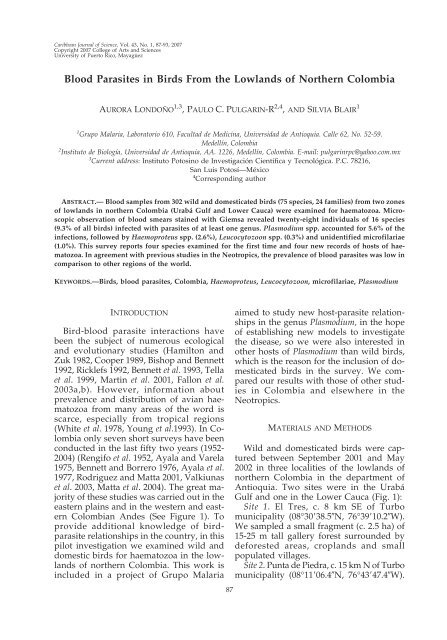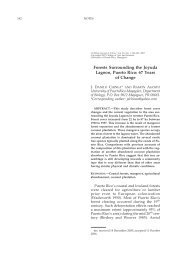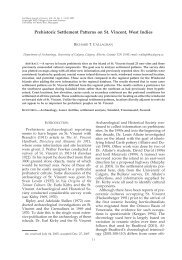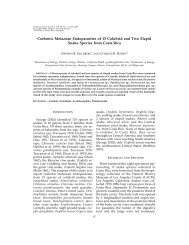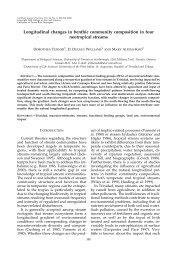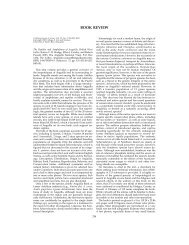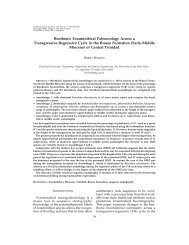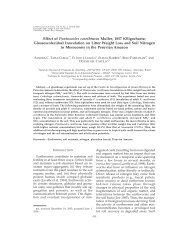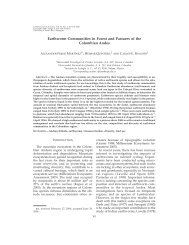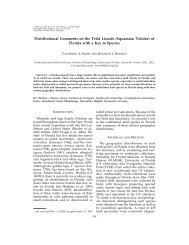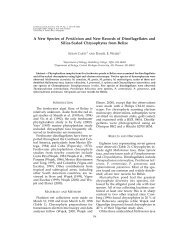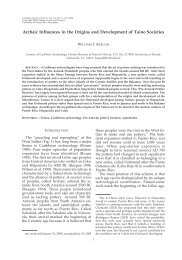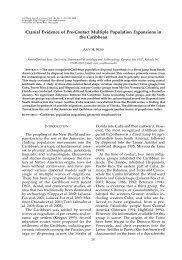Blood Parasites in Birds From the Lowlands of Northern Colombia
Blood Parasites in Birds From the Lowlands of Northern Colombia
Blood Parasites in Birds From the Lowlands of Northern Colombia
Create successful ePaper yourself
Turn your PDF publications into a flip-book with our unique Google optimized e-Paper software.
Caribbean Journal <strong>of</strong> Science, Vol. 43, No. 1, 87-93, 2007<br />
Copyright 2007 College <strong>of</strong> Arts and Sciences<br />
University <strong>of</strong> Puerto Rico, Mayagüez<br />
<strong>Blood</strong> <strong>Parasites</strong> <strong>in</strong> <strong>Birds</strong> <strong>From</strong> <strong>the</strong> <strong>Lowlands</strong> <strong>of</strong> Nor<strong>the</strong>rn <strong>Colombia</strong><br />
AURORA LONDOÑO 1,3 ,PAULO C. PULGARIN-R 2,4 , AND SILVIA BLAIR 1<br />
1 Grupo Malaria, Laboratorio 610, Facultad de Medic<strong>in</strong>a, Universidad de Antioquia. Calle 62, No. 52-59.<br />
Medellín, <strong>Colombia</strong><br />
2 Instituto de Biología, Universidad de Antioquia, AA. 1226, Medellín, <strong>Colombia</strong>. E-mail: pulgar<strong>in</strong>rpc@yahoo.com.mx<br />
3 Current address: Instituto Potos<strong>in</strong>o de Investigación Científica y Tecnológica. P.C. 78216,<br />
San Luis Potosí—México<br />
4 Correspond<strong>in</strong>g author<br />
ABSTRACT.— <strong>Blood</strong> samples from 302 wild and domesticated birds (75 species, 24 families) from two zones<br />
<strong>of</strong> lowlands <strong>in</strong> nor<strong>the</strong>rn <strong>Colombia</strong> (Urabá Gulf and Lower Cauca) were exam<strong>in</strong>ed for haematozoa. Microscopic<br />
observation <strong>of</strong> blood smears sta<strong>in</strong>ed with Giemsa revealed twenty-eight <strong>in</strong>dividuals <strong>of</strong> 16 species<br />
(9.3% <strong>of</strong> all birds) <strong>in</strong>fected with parasites <strong>of</strong> at least one genus. Plasmodium spp. accounted for 5.6% <strong>of</strong> <strong>the</strong><br />
<strong>in</strong>fections, followed by Haemoproteus spp. (2.6%), Leucocytozoon spp. (0.3%) and unidentified micr<strong>of</strong>ilariae<br />
(1.0%). This survey reports four species exam<strong>in</strong>ed for <strong>the</strong> first time and four new records <strong>of</strong> hosts <strong>of</strong> haematozoa.<br />
In agreement with previous studies <strong>in</strong> <strong>the</strong> Neotropics, <strong>the</strong> prevalence <strong>of</strong> blood parasites was low <strong>in</strong><br />
comparison to o<strong>the</strong>r regions <strong>of</strong> <strong>the</strong> world.<br />
KEYWORDS.—<strong>Birds</strong>, blood parasites, <strong>Colombia</strong>, Haemoproteus, Leucocytozoon, micr<strong>of</strong>ilariae, Plasmodium<br />
INTRODUCTION<br />
Bird-blood parasite <strong>in</strong>teractions have<br />
been <strong>the</strong> subject <strong>of</strong> numerous ecological<br />
and evolutionary studies (Hamilton and<br />
Zuk 1982, Cooper 1989, Bishop and Bennett<br />
1992, Ricklefs 1992, Bennett et al. 1993, Tella<br />
et al. 1999, Mart<strong>in</strong> et al. 2001, Fallon et al.<br />
2003a,b). However, <strong>in</strong>formation about<br />
prevalence and distribution <strong>of</strong> avian haematozoa<br />
from many areas <strong>of</strong> <strong>the</strong> word is<br />
scarce, especially from tropical regions<br />
(White et al. 1978, Young et al.1993). In <strong>Colombia</strong><br />
only seven short surveys have been<br />
conducted <strong>in</strong> <strong>the</strong> last fifty two years (1952-<br />
2004) (Rengifo et al. 1952, Ayala and Varela<br />
1975, Bennett and Borrero 1976, Ayala et al.<br />
1977, Rodriguez and Matta 2001, Valkiunas<br />
et al. 2003, Matta et al. 2004). The great majority<br />
<strong>of</strong> <strong>the</strong>se studies was carried out <strong>in</strong> <strong>the</strong><br />
eastern pla<strong>in</strong>s and <strong>in</strong> <strong>the</strong> western and eastern<br />
<strong>Colombia</strong>n Andes (See Figure 1). To<br />
provide additional knowledge <strong>of</strong> birdparasite<br />
relationships <strong>in</strong> <strong>the</strong> country, <strong>in</strong> this<br />
pilot <strong>in</strong>vestigation we exam<strong>in</strong>ed wild and<br />
domestic birds for haematozoa <strong>in</strong> <strong>the</strong> lowlands<br />
<strong>of</strong> nor<strong>the</strong>rn <strong>Colombia</strong>. This work is<br />
<strong>in</strong>cluded <strong>in</strong> a project <strong>of</strong> Grupo Malaria<br />
87<br />
aimed to study new host-parasite relationships<br />
<strong>in</strong> <strong>the</strong> genus Plasmodium, <strong>in</strong> <strong>the</strong> hope<br />
<strong>of</strong> establish<strong>in</strong>g new models to <strong>in</strong>vestigate<br />
<strong>the</strong> disease, so we were also <strong>in</strong>terested <strong>in</strong><br />
o<strong>the</strong>r hosts <strong>of</strong> Plasmodium than wild birds,<br />
which is <strong>the</strong> reason for <strong>the</strong> <strong>in</strong>clusion <strong>of</strong> domesticated<br />
birds <strong>in</strong> <strong>the</strong> survey. We compared<br />
our results with those <strong>of</strong> o<strong>the</strong>r studies<br />
<strong>in</strong> <strong>Colombia</strong> and elsewhere <strong>in</strong> <strong>the</strong><br />
Neotropics.<br />
MATERIALS AND METHODS<br />
Wild and domesticated birds were captured<br />
between September 2001 and May<br />
2002 <strong>in</strong> three localities <strong>of</strong> <strong>the</strong> lowlands <strong>of</strong><br />
nor<strong>the</strong>rn <strong>Colombia</strong> <strong>in</strong> <strong>the</strong> department <strong>of</strong><br />
Antioquia. Two sites were <strong>in</strong> <strong>the</strong> Urabá<br />
Gulf and one <strong>in</strong> <strong>the</strong> Lower Cauca (Fig. 1):<br />
Site 1. El Tres, c. 8 km SE <strong>of</strong> Turbo<br />
municipality (08°3038.5N, 76°3910.2W).<br />
We sampled a small fragment (c. 2.5 ha) <strong>of</strong><br />
15-25 m tall gallery forest surrounded by<br />
deforested areas, croplands and small<br />
populated villages.<br />
Site 2. Punta de Piedra, c. 15 km N <strong>of</strong> Turbo<br />
municipality (08°1106.4N, 76°4347.4W).
88<br />
A. LODOÑO ET AL.<br />
FIG. 1. Studies for haematozoa <strong>in</strong> <strong>Colombia</strong>n birds. Numbers 1, 2, 3 refer to localities <strong>in</strong> <strong>the</strong> text.<br />
We sampled a dry forest patch (c. 2 ha)<br />
surrounded by secondary forest remnants,<br />
croplands and villages. Sites 1 and 2<br />
are at 70 m a.s.l with annual mean temperature<br />
<strong>of</strong> 28°C, and annual ra<strong>in</strong>fall <strong>of</strong><br />
200 cm.<br />
Site 3. El 16, S <strong>of</strong> Zaragoza municipality<br />
(07°3044N, 74°5114W), east bank <strong>of</strong><br />
Nechí river at 55 m a.s.l, with a mean annual<br />
temperature <strong>of</strong> 28°C and annual ra<strong>in</strong>fall<br />
<strong>of</strong> 307.5 cm. We worked on a c. 10 ha<br />
fragment with secondary and mature forest<br />
(25-30 m tall), close to Tafur marsh and San<br />
Nicolas watershed.<br />
Wild birds were mist-netted between 06:<br />
00 h and 13:00 h, and domestic birds were<br />
captured by hand between 14:00 and 17:00<br />
h <strong>in</strong> rural hous<strong>in</strong>g near <strong>the</strong> mist-nett<strong>in</strong>g<br />
sites. Two or three blood smears per bird<br />
were taken from a drop <strong>of</strong> blood from <strong>the</strong><br />
brachial ve<strong>in</strong> us<strong>in</strong>g capillary tubes. Smears<br />
were fixed <strong>in</strong> 100% methanol after air dry<strong>in</strong>g,<br />
and <strong>the</strong>n were sta<strong>in</strong>ed with Giemsa<br />
(pH 7.0 for 40 m<strong>in</strong>) on <strong>the</strong> same day. <strong>Blood</strong><br />
films were first exam<strong>in</strong>ed under low power<br />
(10× and 20×) for micr<strong>of</strong>ilariae and trypanosomes,<br />
cover<strong>in</strong>g all regions <strong>of</strong> <strong>the</strong><br />
smear, and <strong>the</strong>n under oil immersion
BLOOD PARASITES OF COLOMBIAN BIRDS 89<br />
(100×), count<strong>in</strong>g smaller haematozoa <strong>in</strong> 100<br />
microscopic fields (which exceeds <strong>the</strong> m<strong>in</strong>imum<br />
number <strong>of</strong> erythrocytes required for<br />
this k<strong>in</strong>d <strong>of</strong> diagnosis) (Godfrey et al. 1987).<br />
To avoid wrong determ<strong>in</strong>ation <strong>of</strong> Plasmodium<br />
spp. and Haemoproteus spp. due to<br />
similarities <strong>in</strong> <strong>the</strong>ir sexual forms, Plasmodium<br />
spp. was identified by <strong>the</strong> presence <strong>of</strong><br />
both schizonts and round or enlarged gametocytes<br />
<strong>in</strong> <strong>the</strong> blood smear, while <strong>in</strong>fections<br />
by Haemoproteus spp. are characterized<br />
by <strong>the</strong> presence only <strong>of</strong> enlarged<br />
(halteridium) or round gametocytes <strong>in</strong> peripheral<br />
blood. AL and SB <strong>in</strong>dependently<br />
analyzed all blood smears with similar results.<br />
The collection <strong>of</strong> samples was kept at<br />
<strong>the</strong> Malaria Group <strong>in</strong> <strong>the</strong> Faculty <strong>of</strong> Medic<strong>in</strong>e<br />
<strong>of</strong> University <strong>of</strong> Antioquia. F<strong>in</strong>ally,<br />
comparisons <strong>of</strong> percentages <strong>of</strong> parasitism<br />
were made by 2 test (EpiInfo version 6.1),<br />
and values <strong>of</strong> p < 0.05 were considered as<br />
significantly different. Our nomenclature <strong>of</strong><br />
birds follows <strong>the</strong> South American Check<br />
list Committee (SACC, Remsen et al. 2004).<br />
RESULTS<br />
In total, 302 birds (75 species <strong>of</strong> 24 families)<br />
were exam<strong>in</strong>ed for blood parasites<br />
(Table 1). <strong>From</strong> <strong>the</strong> municipality <strong>of</strong> Turbo<br />
(sites 1 and 2), blood smears <strong>of</strong> 140 wild<br />
birds (20 families and 52 species) and 50<br />
domesticated birds (5 families and 5 species)<br />
were exam<strong>in</strong>ed. <strong>From</strong> <strong>the</strong> municipality<br />
<strong>of</strong> Zaragoza (site 3), we exam<strong>in</strong>ed<br />
smears <strong>of</strong> 63 wild birds <strong>of</strong> 32 species (11<br />
families) and 49 domesticated birds <strong>of</strong> two<br />
species (two families). Among wild birds,<br />
<strong>the</strong> families Tyrannidae and Thamnophilidae<br />
were <strong>the</strong> most frequent. Twenty-eight<br />
birds (9.3%) <strong>of</strong> 16 species harbored at least<br />
one genus <strong>of</strong> parasite. Plasmodium, present<br />
<strong>in</strong> 5.6% <strong>of</strong> all birds, was <strong>the</strong> most frequent<br />
haematozoa, followed by Haemoproteus<br />
(2.6%), Leucocytozoon (0.3%) and micr<strong>of</strong>ilariae<br />
(1.0%) (Table 1). <strong>Parasites</strong> were<br />
most frequent <strong>in</strong> passer<strong>in</strong>e birds (81.2% <strong>of</strong><br />
all <strong>in</strong>fected). None <strong>of</strong> <strong>the</strong> seven Nearctic-<br />
Neotropical migratory songbirds harbored<br />
parasites (Table 1).<br />
To our knowledge, four species were exam<strong>in</strong>ed<br />
for haematozoa for <strong>the</strong> first time<br />
(Sakesphorus canadensis, Myrmo<strong>the</strong>rula fulviventris,<br />
Myiod<strong>in</strong>astes chrysocephalus and Formicivora<br />
grisea) (sensu White et al. 1978,<br />
Woodworth-Lynas 1989, Bennett et al. 1991,<br />
Young et al. 1993 and all <strong>the</strong> former <strong>Colombia</strong>n<br />
studies). New host-parasite records <strong>in</strong>clude<br />
White-fr<strong>in</strong>ged Antwren (Formicivora<br />
grisea) with Plasmodium spp., Buff-throated<br />
Foliage-gleaner (Automolus ochrolaemus)<br />
with Leucocytozoon spp., Tawny-throated<br />
Leaftosser (Sclerurus mexicanus) and <strong>the</strong> Bicolored<br />
Wren (Campylorhynchus griseus)<br />
with micr<strong>of</strong>ilariae. Only two species: <strong>the</strong><br />
Tawny-throated Leaftosser and <strong>the</strong> Bananaquit<br />
(Coereba flaveola) had multiple <strong>in</strong>fections<br />
<strong>in</strong> both zones (Table 1).<br />
Comparison <strong>of</strong> total prevalence showed<br />
a pattern similar to o<strong>the</strong>r reports <strong>in</strong> Neotropics.<br />
Also non significant differences<br />
were observed between prevalence <strong>of</strong> haematozoa<br />
<strong>in</strong> wild and domesticated birds.<br />
Differences were observed at <strong>the</strong> level <strong>of</strong><br />
genus <strong>of</strong> parasite when separat<strong>in</strong>g wilds<br />
from domesticated and compar<strong>in</strong>g with<br />
data filtered from White et al. 1978; Plasmodium<br />
spp. was significantly more abundant<br />
<strong>in</strong> our sample <strong>of</strong> domesticated (p = 0.0012)<br />
and Haemoproteus spp. was lower <strong>in</strong> our<br />
sample <strong>of</strong> wild birds (p = 0.0317). No significant<br />
differences for prevalence <strong>of</strong> <strong>in</strong>fected<br />
birds were observed between Turbo<br />
(sites 1 and 2) and Zaragoza (site 3). In<br />
Turbo, Haemoproteus was <strong>the</strong> most frequent<br />
genus <strong>of</strong> parasite, be<strong>in</strong>g present <strong>in</strong> seven <strong>of</strong><br />
14 <strong>in</strong>fected wild birds, and Plasmodium was<br />
<strong>the</strong> most common <strong>in</strong> domesticated species<br />
(5 <strong>of</strong> 5). In Zaragoza, Plasmodium was <strong>the</strong><br />
most frequent <strong>in</strong> both domestic and wild<br />
birds, and Haemoproteus was not found. The<br />
birds <strong>in</strong>fected with Haemoproteus spp. had<br />
relatively high parasitaemia (more than 2<br />
gametocytes/100 erythrocytes), while <strong>in</strong><br />
those <strong>in</strong>fected with Plasmodium spp. <strong>the</strong><br />
parasitaemia was lower and <strong>in</strong> <strong>the</strong> rema<strong>in</strong><strong>in</strong>g<br />
<strong>in</strong>fections, only one to three parasites<br />
were seen <strong>in</strong> <strong>the</strong> smears.<br />
DISCUSSION<br />
The prevalence <strong>of</strong> blood parasites (9.3%)<br />
<strong>in</strong> our study was significantly low compared<br />
with <strong>the</strong> nearest cont<strong>in</strong>ental land<br />
mass (37% <strong>in</strong> Neartic, p < 0.0001, White
90<br />
A. LODOÑO ET AL.<br />
TABLE 1. <strong>Blood</strong> parasites present <strong>in</strong> domesticated and wild birds <strong>in</strong> northwest <strong>Colombia</strong>.<br />
<strong>Birds</strong><br />
Parasite genus<br />
Family and species Exam<strong>in</strong>ed Infected Plasmodium Haemoproteus Leucocytozoon Micr<strong>of</strong>ilariae<br />
ANATIDAE<br />
Cair<strong>in</strong>a moschata 8 ab 3 2 b 1 a<br />
PHASIANIDAE<br />
Gallus gallus 74 ab 7 7 ab<br />
COLUMBIDAE<br />
Columb<strong>in</strong>a talpacoti 1 a 1 1 a<br />
FURNARIIDAE<br />
Automolus ochrolaemus 4 b 1 1 be<br />
Sclerurus mexicanus 1 b 1 1 b 1 be<br />
THAMNOPHILIDAE<br />
Formicivora grisea f 11 a 1 1 ae<br />
COTINGIDAE<br />
Pachyramphus<br />
c<strong>in</strong>namomeus 1 a 1 1 a<br />
Pachyramphus rufus 1 a 1 1 a<br />
Pachyramphus<br />
polychopterus 1 a 1 1 a<br />
TYRANNIDAE<br />
Myiodynastes maculatus 1 a 1 1 a<br />
Mionectes oleag<strong>in</strong>eus 16 ab 1 1 ae<br />
VIREONIDAE<br />
Vireo olivaceus 1 a 1 1 a<br />
TROGLODYTIDAE<br />
Compylorhynchus griseus 1 a 1 1 ae<br />
EMBERIZIDAE<br />
Arremonops conirostris 2 a 1 1 a<br />
COEREBIDAE<br />
Coereba flaveola 4 ab 4 2 b 2 a<br />
THRAUPIDAE<br />
Ramphocelus dimidiatus 12 ab 2 2 a<br />
Un<strong>in</strong>fected unlisted* 163<br />
TOTAL 302 28 17 8 1 3<br />
% Infected 9.3 5.6 2.6 0.3 1.0<br />
a <strong>From</strong> Turbo.<br />
b <strong>From</strong> Zaragoza.<br />
e New record <strong>of</strong> host for <strong>the</strong> respective parasite.<br />
f Species exam<strong>in</strong>ed for haematozoa for <strong>the</strong> first time.<br />
† Refers to boreal migratory birds.<br />
*Un<strong>in</strong>fected species (<strong>the</strong> number <strong>of</strong> birds is <strong>in</strong> paren<strong>the</strong>sis, underl<strong>in</strong>ed species correspond to <strong>the</strong> domesticated<br />
ones): Meleagridae: Meleagris gallopavo a (13); Numididae: Numida meleagirs a (1); Columbidae: Columba livia a (2),<br />
Leptotila verreauxi a (1); Cuculidae: Crotophaga ani a (1); Trochilidae: Glaucis hirsutus a (3), Phaetornis longirostris ab<br />
(9), Phaetornis anthophilus b (1), Heliothryx barroti b (1); Momotidae: Momotus momota a (1); Galbulidae: Galbula<br />
ruficauda a (1); Ramphastidae: Pteroglossus torquatus b (1); Picidae: Colaptes punctigula a (1), Dryocopus l<strong>in</strong>eatus a (1);<br />
Dendrocolaptidae: Xyphorhyncus picus a (2), Xyphorhyncus guttatus a (1), Lepidocolaptes souleyetii a (1), Glyphorhynchus<br />
spirurus b (2), Dendrocolaptes certhia b (1), Dendroc<strong>in</strong>cla fulig<strong>in</strong>osa b (2); Furnariidae: Xenops m<strong>in</strong>utus ab (2); Thamnophilidae:<br />
Gymnopitys leucaspis ba (2); Sakesphorus canadensis bf (1), Myrmo<strong>the</strong>rula fulviventris bf (1), Thamnophilus<br />
doliatus a (2), Thamnophilus nigriceps a (1), Cercomacra tyrann<strong>in</strong>a a (1); Pipridae: Manacus vitell<strong>in</strong>us ab (42), Pipra<br />
erythrocephala ab (8), Pipra coronata b (2); Cot<strong>in</strong>gidae: Schiffornis turd<strong>in</strong>a b (2); Tyrannidae: Leptopogon amaurocephalus<br />
a (1), Poecilotriccus sylvia a (5), Attila spadiceus a (2), Empidonax sp. a† (1), Terenotricus erithrurus b (2), Myiod<strong>in</strong>astes<br />
chrysocephalus bf (1), Myiozetetes cayanensis ab (6), Elaneia frantzii a ? (1), Empidonax traillii ab† (1), Myiarchus tuberculifer<br />
a (1); Troglodytidae: Thryothorus fasciatoventris a (1), Thryothorus leucotis a (1), Troglodytes aedon a (1), Microcerculus<br />
marg<strong>in</strong>atus ab (3); Emberizidae: Oryzoborus crassirostris b (1), Oryzoborus angolensis ab (7), Volat<strong>in</strong>ia jacar<strong>in</strong>a a (4);<br />
Card<strong>in</strong>alidae: Cyanocompsa cyanoides ab (2), Saltator coerulescens b (2), Saltator maximus a (1); Parulidae: Dendroica<br />
petechia a† (1), Dendroica castanea a† (1), Vermivora peregr<strong>in</strong>a a† (1), Oporornis philadelphia a† (1), Basileuterus fulvicauda a<br />
(1), Seirus novoeborascensis a† (1); Thraupidae: Mitrosp<strong>in</strong>gus cass<strong>in</strong>i a (1), Thraupis episcopus a (2).
BLOOD PARASITES OF COLOMBIAN BIRDS 91<br />
et al. 1978, Rodriguez & Matta 2001). It was<br />
also lower than prevalence <strong>in</strong> neighbor<strong>in</strong>g<br />
regions like Caribbean islands and Panama<br />
(ca 30%, p < 0.0001, Fallon et al. 2004 and<br />
18%, p = 0.0008, Sousa and Herman 1982,<br />
respectively). The total prevalence <strong>of</strong> haematozoa,<br />
however, was not different from<br />
o<strong>the</strong>r studies carried out <strong>in</strong> <strong>Colombia</strong> [Bennett<br />
and Borrero (1976: 7.1%), Rodriguez<br />
and Matta (2001:15.9%), Valkiunas et al.<br />
(2003: 7.8%)], and o<strong>the</strong>r Neotropical countries<br />
[Woodworth-Lynas and Bennett (1989:<br />
8%), Young et al. (1993: 11%)]. Many reasons<br />
have been proposed to expla<strong>in</strong> <strong>the</strong> low<br />
frequency <strong>of</strong> blood parasites <strong>in</strong> Neotropical<br />
birds: <strong>the</strong> scarcity <strong>of</strong> vectors (Bennett and<br />
Borrero 1976, White et al. 1978, Young et al.<br />
1993), under-estimation <strong>of</strong> <strong>the</strong> <strong>in</strong>fections by<br />
failure <strong>in</strong> <strong>the</strong> methods to detection <strong>of</strong> parasitized<br />
birds (Bennett et al. 1991, Fallon et al.<br />
2003a) and <strong>the</strong> evolutionary history <strong>of</strong> Neotropical<br />
birds (Ricklefs 1992, Tella et al.<br />
1999). However parasitic relationships vary<br />
widely accord<strong>in</strong>g to host species or <strong>the</strong> geographical<br />
regions, and <strong>the</strong>refore careful<br />
analyses which reflect <strong>the</strong>se dynamics are<br />
needed (Fallon et al. 2003b).<br />
It is important to consider <strong>the</strong> effect <strong>of</strong><br />
<strong>the</strong> diversity <strong>of</strong> host species and sampl<strong>in</strong>g<br />
strategy on <strong>the</strong> prevalence. In 77% <strong>of</strong> <strong>the</strong><br />
exam<strong>in</strong>ed species only one or two <strong>in</strong>dividuals<br />
were captured, as a result <strong>of</strong> <strong>the</strong><br />
opportunistic sampl<strong>in</strong>g. Although a high<br />
diversity would dilute <strong>the</strong> prevalence occurr<strong>in</strong>g<br />
<strong>in</strong> susceptible species by disproportion<br />
<strong>of</strong> non-susceptible species, it was ruled<br />
out because <strong>the</strong> sample size <strong>of</strong> <strong>the</strong> dom<strong>in</strong>ant<br />
species supports <strong>the</strong> reports <strong>of</strong> low<br />
prevalence <strong>of</strong> blood parasites <strong>in</strong> Neotropical<br />
birds. Three species (Gallus gallus, Manacus<br />
vitell<strong>in</strong>us and Mionectes oleag<strong>in</strong>ea) conform<br />
44% <strong>of</strong> <strong>the</strong> sample, which mean <strong>the</strong>y<br />
are overrepresented. Two <strong>of</strong> <strong>the</strong>se species<br />
are known as susceptible to haematozoa (G.<br />
gallus and M. vitell<strong>in</strong>us) (White et al. 1978,<br />
Bishop and Bennett 1992), but <strong>the</strong>ir specific<br />
prevalence wasn’t as high as <strong>in</strong> o<strong>the</strong>r parts<br />
<strong>of</strong> <strong>the</strong> world, and didn’t generate an augment<br />
<strong>in</strong> <strong>the</strong> general prevalence. Probably<br />
<strong>the</strong> diversity allowed <strong>the</strong> equilibrium between<br />
non-susceptible and overrepresented<br />
susceptible species. The prevalence<br />
by genera was affected by <strong>the</strong> sample size<br />
<strong>of</strong> host species. In comparisons <strong>of</strong> prevalence<br />
separat<strong>in</strong>g wild from domesticated<br />
birds <strong>the</strong> total prevalence <strong>of</strong> haematozoa <strong>in</strong><br />
wilds was similar to <strong>the</strong> Neotropics (us<strong>in</strong>g<br />
<strong>in</strong>formation filtrated from White et al.<br />
1978), but some differences were observed<br />
at <strong>the</strong> level <strong>of</strong> genera. In <strong>the</strong> case <strong>of</strong> <strong>in</strong>fections<br />
by Plasmodium spp., G. gallus had a<br />
highest percentage <strong>of</strong> <strong>the</strong> <strong>in</strong>fections which<br />
is <strong>the</strong> source <strong>of</strong> augmented frequency <strong>of</strong><br />
this genus <strong>in</strong> our sample <strong>of</strong> domesticated<br />
birds. This situation put Plasmodium spp. as<br />
<strong>the</strong> most frequent parasite <strong>in</strong> our overall<br />
sample, <strong>in</strong>stead <strong>of</strong> Haemoproteus spp., as<br />
had been observed <strong>in</strong> o<strong>the</strong>r studies reported<br />
<strong>in</strong> <strong>Colombia</strong> (Rodriguez and Matta<br />
2001, Valkiunas et al. 2003).<br />
A handful <strong>of</strong> reasons besides <strong>the</strong> biology<br />
<strong>of</strong> Neotropical birds could expla<strong>in</strong> <strong>the</strong> percentage<br />
<strong>of</strong> prevalence found <strong>in</strong> this work. A<br />
direct relationship between high parasite<br />
prevalence and wet season, breed<strong>in</strong>g period<br />
and hormonal conditions has been reported<br />
(e.g. Young et al. 1993 and Deviche et<br />
al. 2001 as examples). The low prevalence<br />
<strong>of</strong> haematozoa <strong>in</strong> our sample <strong>of</strong> wild birds<br />
may be a mixture <strong>of</strong> factors: one is that<br />
most birds (67%) were caught dur<strong>in</strong>g <strong>the</strong><br />
dry season, <strong>in</strong> <strong>the</strong> months <strong>of</strong> February and<br />
early May, before <strong>the</strong> proliferation <strong>of</strong> mosquitoes;<br />
<strong>the</strong> second is that only 18% <strong>of</strong> <strong>the</strong><br />
birds were breed<strong>in</strong>g, <strong>the</strong>refore <strong>the</strong>re were<br />
fewer <strong>in</strong>dividuals susceptible to vector bit<strong>in</strong>g.<br />
A good explanation for <strong>the</strong> low parasite<br />
presence <strong>in</strong> domesticated birds is difficult<br />
due to many factors <strong>in</strong>volved <strong>in</strong> <strong>the</strong>ir<br />
human habitat. A model propos<strong>in</strong>g a relationship<br />
between endemic zones for human<br />
malaria and prevalence <strong>of</strong> avian malaria<br />
was proposed by Gabaldon and Ulloa<br />
(1980), <strong>in</strong> which is established that <strong>the</strong> bioclimatic<br />
conditions <strong>of</strong> this zones facilitate<br />
<strong>the</strong> <strong>in</strong>fection <strong>of</strong> several families <strong>of</strong> birds, especially<br />
marsh birds. <strong>From</strong> that view, <strong>the</strong><br />
low prevalence could come from a low<br />
number <strong>of</strong> mosquitoes <strong>in</strong> <strong>the</strong> zones studied<br />
as a result <strong>of</strong> ongo<strong>in</strong>g control programs.<br />
S<strong>in</strong>ce Turbo (Urabá) and Zaragoza (Nechí)<br />
are endemic zones for human malaria, and<br />
dengue fever is also frequent, spray<strong>in</strong>g <strong>of</strong><br />
<strong>the</strong> surround<strong>in</strong>g forest is common to control<br />
several mosquito species. Even so, Plas-
92<br />
A. LODOÑO ET AL.<br />
modium (60% <strong>of</strong> all <strong>in</strong>fections) was <strong>the</strong> most<br />
common protozoa <strong>in</strong> domesticated birds,<br />
which makes <strong>the</strong> availability <strong>of</strong> vectors a<br />
poor explanation <strong>of</strong> <strong>the</strong> phenomena, at<br />
least it were species <strong>of</strong> mosquito resistant to<br />
that k<strong>in</strong>d <strong>of</strong> <strong>in</strong>secticide. We claim that biologic<br />
factors (immunology, ecology, behavior,<br />
to mention someth<strong>in</strong>g) <strong>of</strong> Neotropical<br />
birds more than sampl<strong>in</strong>g methods are account<strong>in</strong>g<br />
for <strong>the</strong> observed prevalence <strong>of</strong><br />
blood parasites <strong>in</strong> <strong>the</strong> Neotropics.<br />
Never<strong>the</strong>less, we cannot conclude unerr<strong>in</strong>gly<br />
that <strong>the</strong>re is a low frequency <strong>of</strong><br />
haematozoa <strong>in</strong> <strong>the</strong> lowlands <strong>of</strong> nor<strong>the</strong>rn<br />
<strong>Colombia</strong>. We have exam<strong>in</strong>ed different<br />
groups <strong>of</strong> birds with different life histories<br />
at different seasons and with few samples<br />
per bird species, which limits our possibilities<br />
to do comparisons, a disadvantage <strong>of</strong><br />
our sampl<strong>in</strong>g method. Opportunistic sampl<strong>in</strong>g<br />
has advantages only <strong>in</strong> unexplored<br />
areas where <strong>in</strong>formation <strong>of</strong> both, biodiversity<br />
<strong>of</strong> birds and blood parasites is unknown<br />
and also leaves a wider possibility<br />
to f<strong>in</strong>d new hosts <strong>of</strong> parasites. Groupdirected<br />
studies, on <strong>the</strong> o<strong>the</strong>r hand, have<br />
more advantages to establish prevalence.<br />
For example <strong>the</strong> families Tyrannidae, Cot<strong>in</strong>gidae<br />
and Furnariidae (sensu Remsen et<br />
al. 2004) are almost never <strong>in</strong>fected <strong>in</strong> o<strong>the</strong>r<br />
studies (like Bennett et al. 1991, Young et al.<br />
1993), but had more <strong>in</strong>fected species <strong>in</strong> our<br />
work than <strong>in</strong> <strong>the</strong>irs (Table 1), and moreover<br />
<strong>the</strong>se families had an <strong>in</strong>creased frequency<br />
<strong>of</strong> parasites <strong>in</strong> family focused studies as<br />
Matta et al. (2004). We suggest that without<br />
statistically designed studies with broad<br />
host samples from different seasons and at<br />
<strong>the</strong> same localities, it is difficult to draw<br />
conclusions regard<strong>in</strong>g <strong>the</strong> level <strong>of</strong> prevalence<br />
as such. It is better to carry out detailed<br />
exam<strong>in</strong>ations <strong>of</strong> specific groups <strong>of</strong><br />
birds (Tella et al. 1999, Matta et al. 2004).<br />
New analyses and additional data, <strong>in</strong>clud<strong>in</strong>g<br />
biology <strong>of</strong> both vertebrate and <strong>in</strong>vertebrate<br />
host, life cycles, physiology and genetic<br />
backgrounds are needed to resolve<br />
many questions about bird-parasite <strong>in</strong>teractions.<br />
Although <strong>the</strong> parasites have not been<br />
identified at <strong>the</strong> level <strong>of</strong> species, this short<br />
exploration is <strong>the</strong> first from this part <strong>of</strong> <strong>Colombia</strong>,<br />
and adds to our knowledge for<br />
<strong>the</strong> bird-parasite relationships <strong>in</strong> South<br />
America. Explorations with more ref<strong>in</strong>ed<br />
methods are required, because <strong>in</strong> 52 years<br />
only eight studies (<strong>in</strong>clud<strong>in</strong>g ours), and<br />
about 440 total species (c. 22% <strong>of</strong> <strong>the</strong> <strong>Colombia</strong>n<br />
avifauna) <strong>of</strong> birds have been exam<strong>in</strong>ed.<br />
Additional methods for haematozoa<br />
identification are also necessary to<br />
understand <strong>the</strong> ecological and evolutionary<br />
relationships between hosts, parasites and<br />
vectors occurr<strong>in</strong>g <strong>in</strong> <strong>the</strong> Neotropics.<br />
Acknowledgments.—We are <strong>in</strong>debted to<br />
Corantioquia and Corpourabá (entities that<br />
regulate <strong>the</strong> use <strong>of</strong> regional natural resources)<br />
for permission to catch birds <strong>in</strong><br />
<strong>the</strong>ir ecological jurisdiction, and to Servicio<br />
de Erradicación de Malaria <strong>in</strong> Turbo and<br />
Zaragoza for <strong>in</strong>troduc<strong>in</strong>g us to <strong>the</strong> forests.<br />
We thank Gabriel J. Colorado, Juan F. Díaz<br />
and Ana M. Castaño for <strong>the</strong>ir collaboration<br />
dur<strong>in</strong>g field work. Lastly to Sylvia M. Fallon<br />
and John T. Klicka for review<strong>in</strong>g <strong>the</strong><br />
manuscript, and Luciane Willcox for provid<strong>in</strong>g<br />
<strong>in</strong>formation about Brazilian blood<br />
parasite studies.<br />
LITERATURE CITED<br />
Ayala S. C., J. M. Rammakka, V. F. Rammakka, and<br />
C. E. Varela. 1977. Haemoproteus, Plasmodium, and<br />
Hippoboscid ectoparasites <strong>of</strong> <strong>Colombia</strong> wild<br />
doves. Rev. Inst. Med. Trop. Sao Paulo 19:411-416.<br />
Ayala, S. C., and C. E. Varela. 1975. Malaria en Chordeiles<br />
m<strong>in</strong>or (Aves: Caprimulgidae), an <strong>in</strong>tercont<strong>in</strong>ental<br />
migrant. Rev. Inst. Med. Trop. Sao Paulo 17:253-<br />
256.<br />
Bennett, G. F., and J. I. Borrero. 1976. <strong>Blood</strong> parasites<br />
<strong>of</strong> some birds from <strong>Colombia</strong>. J. Wildl. Dis. 12:454-<br />
458.<br />
Bennett, G. F., M. Garv<strong>in</strong>, and J. Bates 1991. Avian<br />
haematozoa from west-central Bolivia. J. Parasitol.<br />
77:207-211.<br />
Bennett, G. P., M. A. Peirce, and R. W. Ashford. 1993.<br />
Avian haematozoa: Mortality and pathogenicity.<br />
J. Nat. Hist. 27:329-334.<br />
Bishop, M. A., and G. F. Bennett. 1992. Host-parasite<br />
catalogue <strong>of</strong> <strong>the</strong> avian haematozoa, Supplement 1<br />
and Bibliography <strong>of</strong> <strong>the</strong> avian blood-<strong>in</strong>habit<strong>in</strong>g<br />
haematozoa, Supplement 2. Meml. Univ. Nfld.<br />
Ocass. Pap. Biol. 15:1-244.<br />
Cooper, J. E. 1989. Diseases and threatened birds. The<br />
significance <strong>of</strong> avian haematozoa <strong>in</strong> conservation<br />
strategies. ICPB, London, UK.<br />
Deviche, P., E. C. Gre<strong>in</strong>er, and X. Manteca. 2001. Seasonal<br />
and age-related changes <strong>in</strong> blood parasite
BLOOD PARASITES OF COLOMBIAN BIRDS 93<br />
prevalence <strong>in</strong> Dark-eyed Juncos (Junco hyemalis,<br />
Aves, Passeriformes). J. Exp. Zool. 289:456-66.<br />
Fallon, S. M., E. Berm<strong>in</strong>gham, and R. E. Rickfles.<br />
2003a. Island and taxon effects <strong>in</strong> parasitism revisited:<br />
Avian malaria <strong>in</strong> <strong>the</strong> Lesser Antilles. Evolution<br />
57:606-615.<br />
Fallon, S. M., R. E. Ricklefs, B. L. Swanson, and E. Berm<strong>in</strong>gham.<br />
2003b. Detect<strong>in</strong>g avian malaria: an improved<br />
polymerase cha<strong>in</strong> reaction diagnostic.<br />
J. Parasitol. 89:1044-7.<br />
Fallon S. M., R. E, Ricklefs, S.C, Latta, and E. Berm<strong>in</strong>gham.<br />
2004. Temporal stability <strong>of</strong> <strong>in</strong>sular avian<br />
malarial parasite communities. Proc. Biol. Sci.<br />
271(1538):493-500.<br />
Gabaldon A., Ulloa G. 1980. Holoendemicity <strong>of</strong> malaria:<br />
an avian model. Trans. R. Soc. Trop. Med. Hyg.<br />
74(4):501-507.<br />
Godfrey, R. D., A. M. Fedynich, and D. B. Pence. 1987.<br />
Quantification <strong>of</strong> haematozoa <strong>in</strong> blood smears.<br />
J. Wildl. Dis. 23:558-565.<br />
Hamilton, W. D., and M. Zuk. 1982. Heritable true<br />
fitness and bright birds: A role for parasites? Science<br />
218:384-387.<br />
Mart<strong>in</strong>, T. E., A. P. Moller, S. Mer<strong>in</strong>o, and J. Clobert.<br />
2001. Does clutch size evolve <strong>in</strong> response to parasites<br />
and immunocompetence?. Proc. Natl. Acd. Sci.<br />
USA. 98:2071-2076.<br />
Matta, N. E., N. Bastos, R. Gutiérrez, O. A. Rodríguez,<br />
and E. C. Gre<strong>in</strong>er. 2004. Prevalence <strong>of</strong> blood parasites<br />
<strong>in</strong> Tyrannidae (flycatchers) <strong>in</strong> <strong>the</strong> eastern<br />
pla<strong>in</strong>s <strong>of</strong> <strong>Colombia</strong>. Mem. Inst. Oswaldo Cruz. 99:<br />
271-274.<br />
Remsen, J. V. Jr., et al. Version [June 18, 2004]. A classification<br />
<strong>of</strong> <strong>the</strong> bird species <strong>of</strong> South America.<br />
American Ornithologist’s Union, Baton Rouge,<br />
Louisiana. Available from: http://www.museum<br />
.lsu.edu/∼Remsen/SACCBasel<strong>in</strong>e.html<br />
Rengifo, S., C. Sanmartín, and J. de Zuleta. 1952.<br />
A survey <strong>of</strong> <strong>the</strong> blood parasites <strong>of</strong> vertebrates <strong>in</strong><br />
eastern <strong>Colombia</strong>. Acta Trop. 9:151-169.<br />
Ricklefs, R. E. 1992. Embryonic development period<br />
and <strong>the</strong> prevalence <strong>of</strong> avian blood parasites. Proc.<br />
Natl. Acd. Sci. USA. 89:4722-4725.<br />
Rodriguez, O. A., and N. E. Matta. 2001. <strong>Blood</strong> parasites<br />
<strong>in</strong> some birds from eastern pla<strong>in</strong>s <strong>of</strong> <strong>Colombia</strong>.<br />
Mem. Inst. Oswaldo Cruz. 96:1173-1176.<br />
Sousa, O. E., and C. M. Herman. 1982. <strong>Blood</strong> parasites<br />
<strong>of</strong> birds from Chiriqui and Panama Prov<strong>in</strong>ces <strong>in</strong><br />
<strong>the</strong> Republic <strong>of</strong> Panama. J. Wildl. Dis. 18(2):205-21.<br />
Tella, J. M., et al. 1999. Habitat, world geographic<br />
range, and embryonic development <strong>of</strong> host expla<strong>in</strong><br />
<strong>the</strong> prevalence <strong>of</strong> avian haematozoa at small spatial<br />
and phylogenetic scales. Proc. Natl. Acad. Sci.<br />
USA. 96:1785-789.<br />
Valkiunas, G., P. Salaman, and T. A. Lezhova. 2003.<br />
Paucity <strong>of</strong> haematozoa <strong>in</strong> <strong>Colombia</strong>n <strong>Birds</strong>.<br />
J. Wildl. Dis. 39:445-448.<br />
White, E. M., E. C. Gre<strong>in</strong>er, G. F. Bennett, and C. M.<br />
Herman. 1978. Distribution <strong>of</strong> haematozoa <strong>of</strong> Neotropical<br />
birds. Rev. Biol. Trop. 26:43-102.<br />
Woodworth-Lynas, C. B., J. R. Ca<strong>in</strong>es, and G. F. Bennett.<br />
1989. Prevalence <strong>of</strong> avian haematozoa <strong>in</strong> Sao<br />
Paulo State, Brazil. Mem. Inst. Oswaldo Cruz. 84:<br />
515-526.<br />
Young, B. E., M. C. Garv<strong>in</strong> and D. B. MacDonald. 1993.<br />
<strong>Blood</strong> parasites <strong>in</strong> birds from Monteverde, Costa<br />
Rica. J. Wildl. Dis. 29:555-560.


